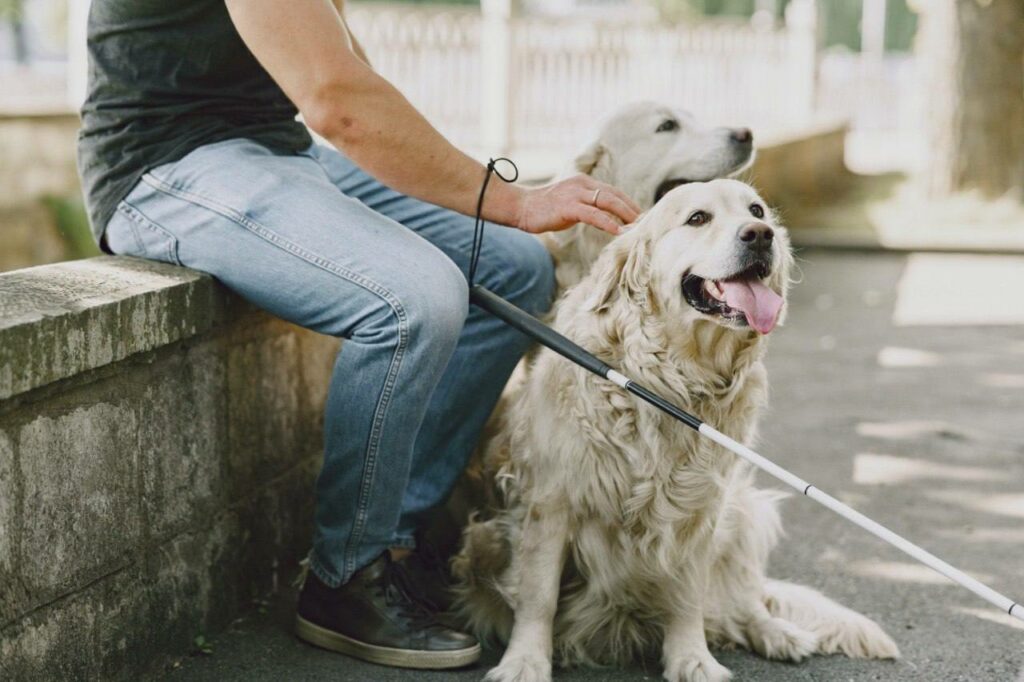Sustainable tourism theory: Accessible tourism How to improve the experience for blind people
This world is becoming less and less welcoming and more complex. I have chosen to devote some space to a topic close to my heart, on which I would like to do some research, testing and spreading good practice. I am talking about accessible tourism.
There is no shortage of positive cases, but I hope this becomes the norm in theory and practice.

First and foremost, I suggest an active approach to improving reception by suggesting experiencing first-hand what it can be like to be visually impaired. Putting yourself in the shoes of a visually impaired person is possible by using glasses or other tools that simulate low vision.
The phases of contact or booking with blind guests are the same as for visually able guests, but the handling requires slightly different precautions.
The contact steps are:
- Searching for information
- Booking
- Arrival at destination
- Stay, experience or visit
- Departure and return home.
The first stage of information seeking requires that our promotion tools are suitable or can be adapted to the blind person.
For example, the online material (the website) or social media where we post must allow us to include either software reading of the text or audio material.
Fonts should be able to be enlarged to facilitate reading by visually impaired people.
Reservations can also be made independently for blind people via the Internet if our website is equipped with audio or if there is the possibility of enlarging the characters for visually impaired people. The reservation can also be made over the phone. In this case, as with all other bookings by telephone, we must ensure we have all the data to transcribe into our management software.
During the welcome on arrival, it is imperative to speak directly with our guest, even if accompanied, to explain well the characteristics of the location and especially obstacles that could trip him up, be it hotel, restaurant or bar, but not to give too much information at once.
Ask the guest if he or she wishes to be accompanied to the table or room and make himself available if he replies no. Limit touching the guests as much as possible, leaving this option for last to get their attention, especially if friends or family accompany him or her.
As with everyone, make yourself available for information and other needs during the guest’s stay. Provide audio material to get to know and appreciate the area and, in general, suggest visiting places where the guest can also discover the local beauty by touch (e.g., botanical gardens and museums).
When checking out, the receipt should be read before printing and confirmed before payment. Printing should be done in large print.
Greetings should be made as usual, depending on the guest’s involvement, by thanking them, in some cases by shaking hands and only for guests with whom you have bonded the most and who are more extroverted with a hug (always asking first and if the type of relationship established allows it).
Social media or the channel you choose to keep in touch with guests should henceforth include audio files, or you should make sure that the guest has voice-reading apps.
Some extra details for hotels and accommodation
Check-in: reception staff should introduce themselves to visually impaired guests by giving their name, specifying their job title, and informing the guest what services, if any, are available.
A welcome kit could be planned and delivered to facilitate communication and keep guests manageable on arrival. A box containing all the essential information that makes them autonomous during the stay.
The Welcome Kit should include information materials in different formats, with helpful information for mobility and understanding of the services in the accommodation unit, the neighbourhood area in which the accommodation unit is located, and the accommodation directory.
The distribution of tactile maps and menus of various restaurants with Braille and enlarged text characters supports all.
Spostamento nella struttura – Tecniche di guida:
Se l’assistenza è stata accettata, si può offrire il braccio per l’ospite, a cui verranno indicate le modifiche apportate nel terreno, come le scale, gli spazi stretti, le scale mobili. Il personale non deve toccare o rimuovere il bastone guida senza che sia stato espressamente richiesto dall’ospite, ed allo stesso modo non dovrebbe interferire con i cani guida.
Segnaletica: Le segnaletiche delle varie strutture dell’hotel dovrebbero essere a caratteri grandi, in braille oppure con sistema audio ( via QR code ad esempio) integrato.
Camere: Agli ospiti con disabilità visive dovrebbe essere offerto un approfondito orientamento delle proprie camere. Se l’ospite accetta l’offerta, il personale dovrebbe spiegare la posizione del letto, della scrivania, del termostato, della televisione, degli interruttori, dell’armadio, del telefono. Il personale deve anche spiegare come funzionano le tende e spiegare se sono aperte o chiuse, e se i vetri delle finestre sono opachi o trasparenti.
Quando il personale intende orientare l’ospite per il bagno dovrebbe spiegare come far funzionare la doccia, dove si trova la biancheria, quali accessori per l’igiene personale (shampoo, lozione, sapone, ecc.) sono forniti e come distinguere gli uni dagli altri.
Infine il personale deve informare gli ospiti sull’uscita di emergenza e sulle norme di sicurezza della struttura.
Le istruzioni per l’evacuazione di emergenza devono essere fornite in un modo che possa essere utilizzato efficacemente in caso di emergenza.
Check-out: Il personale deve dare all’ospite una copia stampata della sua fattura. Se richiesto, si dovrebbe anche fornire una copia stampata a caratteri grandi.
Moving around the facility – Driving techniques:
If assistance has been accepted, the guest can be offered the arm, to which changes in the terrain, such as stairs, narrow spaces, and escalators, will be pointed out. Staff must not touch or remove the guide stick without being specifically requested by the guest and should not interfere with guide dogs.
Signage: Signs in the various hotel facilities should be in large letters, Braille or with an integrated audio system (via QR code, for example).
Rooms: Visually impaired guests should be offered a thorough orientation of their rooms. If the guest accepts the offer, the staff should explain the position of the bed, desk, thermostat, television, switches, wardrobe, and telephone. The staff should also explain how the curtains work, whether open or closed, and whether the window panes are opaque or transparent.
When staff intend to direct the guest to the bathroom, they should explain how to operate the shower, where the linen is located, what personal hygiene accessories (shampoo, lotion, soap, etc.) are provided and how to distinguish one from the other.
Finally, the staff must inform guests about the emergency exit and the facility’s safety regulations.
Emergency evacuation instructions must be provided in a manner that can be used effectively in an emergency.
Check-out: Staff should give the guest a printed copy of their invoice. If requested, a large print copy should also be provided.
Some extra details for catering
When introducing yourself to the customer, draw his attention by calling his name or lightly touching his arm.
If the customer asks to be guided, offer him your arm and proceed with him.
Always warn of the presence of one or more steps and indicate whether they are up or down. Adjust in this way, even if there are escalators.
Ask if he prefers your arm or the handrail; if so, have him place his hand on the handrail.
To show the customer where he can sit, inform him of the chair’s location and have him place his hand on the backrest.
Always let them know if you leave or return. When describing the position of objects, do so by giving spatial references concerning the customer’s position.
If you are asked to accompany the client to the toilet, if you are of the same sex, go in with him/her and describe the type of toilet, the location of sanitary facilities and equipment such as the toilet roll holder and towel.
Inform him/her about the hygienic situation in the environment. If you are not of the same sex, get help from someone who is.
Punctuality is critical for these customers, particularly long waits that cause discomfort and stress.
Remember that only 10-15% of people with visual impairments know the Braille alphabet, so try to provide more forms of communication.
Here are examples of Italian hotels committed to continuous accessibility improvement for all.
The Fra i Sassi residence in Matera is located in a fascinating place, as the name Fra i Sassi suggests. The desire to improve and invest in the business has led the hotel to be appreciated for its accessibility features, particularly for people with sensory disabilities (deaf and blind).
The Holiday Village Floretz is in Comacchio in the magnificent Po Delta Park. It consists of 200 shady pitches and 215 holiday homes.
The entire village has been built to guarantee total accessibility of spaces and allow even those with mobility difficulties to move around completely.
Sources
Sara – tourism sector consultant
PS. Do you want to GROW your business with a POSITIVE impact… without huge investments? Sign up for the email list by clicking on START HERE!
Or click this link https://www.sustainabletourismworld.com/start-here/ to download my INFOGRAPHIC!
